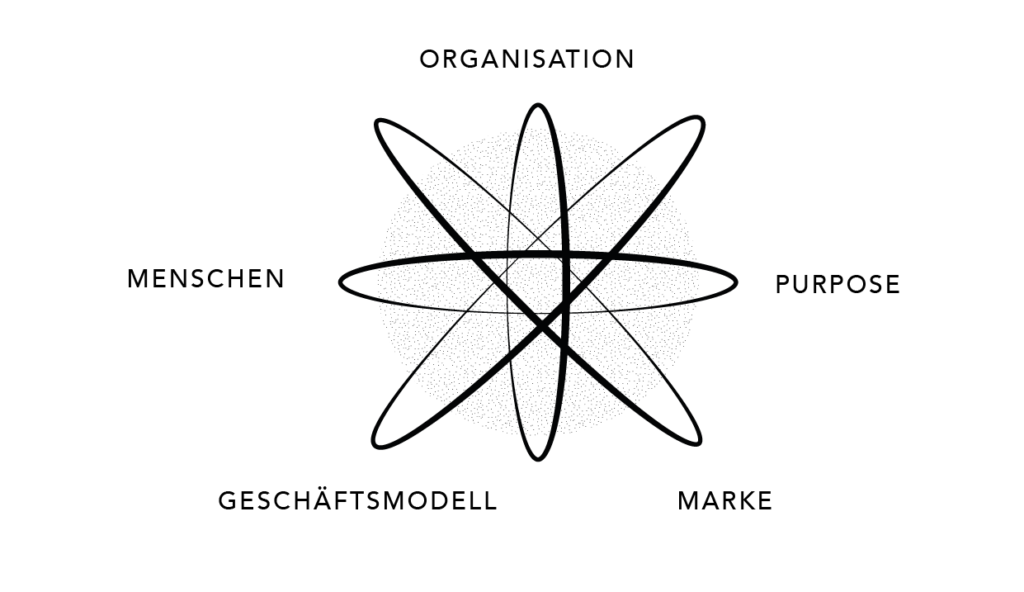For what?
Building on the research project described at the beginning, we have developed
identified fields of action across all four quadrants that are crucial for an organization to get into a flow that enables it to tap into its future potential. "Rethinking communication" is already integrated into all five fields of action - the so-called flow factors: evolutionary purpose, people, the organization, the brand as an interface to customers and the business model as a generic mechanism for sustainable economic success. With an integral view of these factors, it is possible to make the organization future-proof, adaptable, resilient and agile and to give employees and customers a clear orientation in complex situations.
Example
25 years after its foundation, a design and communications agency is
In a phase of business success, companies are facing tensions in their workforce: how can we retain talent for longer and tie it to the company? How can we remain an attractive employer for Generation Z, who are approaching management with a new world view? Closely linked to this is the question of how the agency's founding story, which emerged from design thinking, can be continued into the future and which culture-forming elements can be derived from it. In a joint "flow discovery workshop", we provided all participants with insights into the purpose, the feelings and thoughts of the employees, the structures of collaboration, the customers and also the business model, which made it possible to embark on a journey to open up the new world.
future potential and to embark on the journey with an open narrative.
What matters
Instead of longing for the old, now is the right time to look ahead innovatively, inspire customers and co-create business models. Flow is created through an integral view of the following flow factors:
Purpose: This arises from within and serves as an evolutionary center around which everything constantly develops. A meaning and purpose that makes it easy to decide what to do and what to leave alone. This gives the flow a common direction. Important: You don't give yourself a purpose, you listen to it - as already described in several places in this book.
People: People's attitudes and behaviour can have a strong influence on an organization's agility. Flow can be significantly supported by working together on people's mindset - for example by working on attitudes, values or the feedback and error culture.
Brand: A brand is more than just a name and a logo. It is the expression of identity, will and describes the emotional relationship between an organization and its audience. An integral brand strengthens relationships and creates solidarity.
Business model: This is the central innovation factor in companies and describes the way in which a company creates and maintains value. In a complex environment, it is important that business models are designed to be alive. Old-school strategic planning has had its day. Today, business models are developed in future spaces, co-created together with customers and implemented using dynamic management techniques such as Objectives & Key Results (OKRs), which ensure a clear focus.
Organization: This is about the way we work together - about roles, tasks, working methods and communication processes. Sometimes it is also about synchronizing parallel worlds. There is no master plan, because every organization knows best which skills and practices make it successful.
Step by step
The flow discovery workshop process requires two facilitators who are also responsible for timekeeping and tech hosting. The flow of the workshop is as follows:
Step 1 (10 min.): Check-in
- What has your attention?
Step 2 (5 min.): Tour of the virtual whiteboard and explanation of the intention of Flow Discovery
Step 3 (5 min.): Flow in the organization / introduction to the concept
Step 4 (7 min.): Warm-up
Step 5 (10 min.): Purpose quick check using Simon Sinek's model:
- How do you define purpose in your organization?
- What contribution does the organization make to society?
- What impact does your organization have on the lives of others?
Step 6 (10 min.): Classification of your own brand according to performance and relationship criteria
- What do you mean by "brand"?
- What does your brand stand for today?
- How does the brand affect relationships with your customers and other stakeholders?
Step 7 (10 min.): Business model discussion based on the business model
Canvas
- How do you achieve success as a team?
- Which customer problem do you solve?
- Which value flows are important for the development of the organization?
Step 8 (10 min.): Employees and cooperation
- Describe three to five specific situations and experiences that you have had in your organization in the last six months and that you consider to be characteristic.
Step 9 (10 min.): Structure and organization
- Draw a picture of your current organizational structure and interpret it.
Step 10 (30 min.): Tactical Meeting
- Make a list of tensions that you perceived during the walk through the five flow factors.
- Try to define a concrete next step for addressing each voltage.
Step 11 (15 min.): Ideation
- Set the timer one last time to sketch out a usable minimal version - a minimum viable product of a transformation journey.
Step 12 (10 min.): Check-out
- What do you take away from the workshop?
- What is your next step?
- A virtual whiteboard for Flow Discovery is available to you as a digital extra.
Framework
Duration: approx. 3 hours (please work with timeboxing)
Format: virtual (e.g. working together on a virtual whiteboard)
during a video conference) or in person in a suitable room
Participants: Team of at least 3 - 4 (max. 20 - 30) members to create a space for interaction
You can find more information on this and other tools for overcoming business challenges with communicative means in the book




